#mcmurdo station
Explore tagged Tumblr posts
Text


Pressure ridges, McMurdo Sound, Antarctica.
October 2024.
#antarctica#antarctic exploration#antarctic press#antarctic#south pole#southern ocean#penguins#ice#winter aesthetic#aesthetic#pressure ridges#mcmurdo sound#ross sea#ross island#scott base#mcmurdo station#antartide#seals#ross seals#texture#original photographers#cold#polar science#polar biology#polar exploration#ice shelf#camping#polar explorers#polar expedition#photo
1K notes
·
View notes
Text
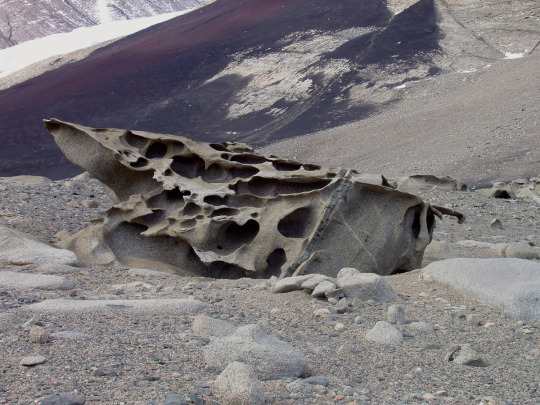
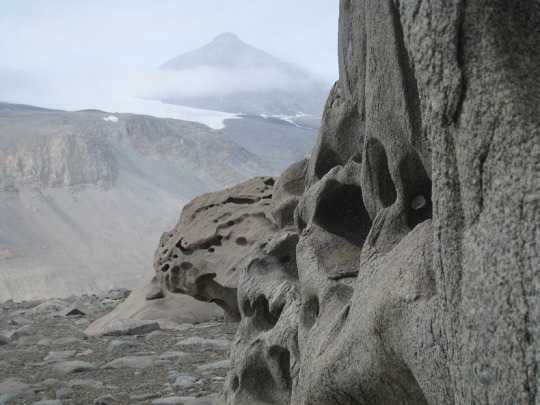

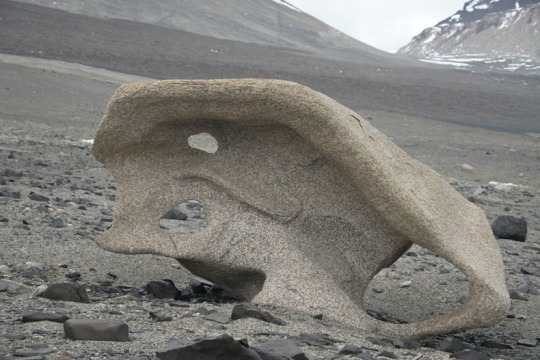
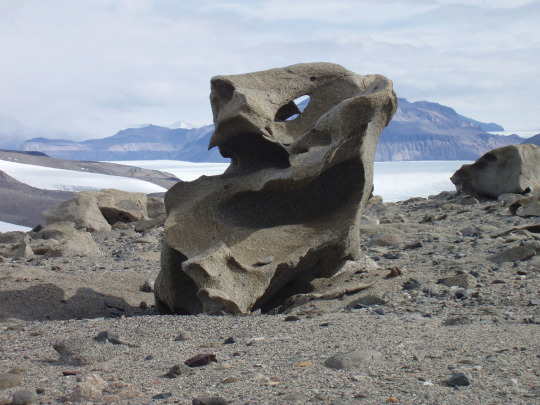
The aeolian processes of katabatic winds in Antarctica’s McMurdo Dry Valleys shape boulders into surreal formations
#ultimate life goal is to visit here#antarctica#mcmurdo station#mcmurdo dry valleys#desert#geomorphology#geology#rocks#aeolian processes#aeolian landform#earth science
5K notes
·
View notes
Text

even all the way from antarctica 🇦🇶 ❤️ 🇵🇸
66 notes
·
View notes
Text
McMurdo Internet
Internet service is supplied to Antarctica via a geostationary satellite. This far south, the satellite is only a few degrees above the horizon, and unfortunately for McMurdo, it's behind Mt Erebus. So the signal is beamed to a receiver on Black Island, about 20 miles away to the southwest, and bounced over to the sheltered alcove at the end of the Hut Point Peninsula where McMurdo sits.
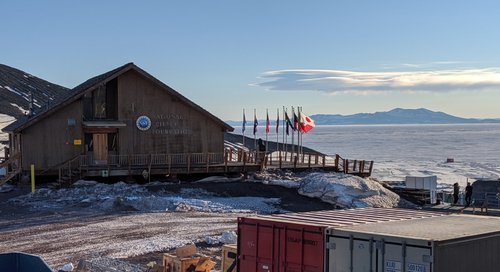
The Chalet, administrative hub, with Black Island in the distance
The Black Island telecommunications infrastructure was installed in the 1980s, long before the internet we know and love today. It was upgraded in 2010 to allow more data transfer, mainly realtime weather data to feed into global forecast models. For this reason, it's probably the only place I've ever been where upload speed is remarkably faster than download speed – 60Mbps for outbound traffic, but only 20Mbps for inbound. Most regular internet use is receiving, not sending, so that's an entire base running on a connection that's only marginally faster than the average American smartphone. As you can imagine, this is somewhat limiting.
The limits to one's internet access actually begin before one even reaches the Ice. At the orientation in Christchurch, one is directed to a URL from which one must download and install a security programme from the U.S. government. It may feel like a hippie commune full of nerds, but McMurdo is an installation of the American state, and as such its computer network is a target of whatever disgruntled conspiracy theorist decides to hack The Man on any given day. Computers that are allowed onto this network (such as the one on which I am typing right now) have to have an approved firewall and antivirus service installed, then this extra programme on top of them. I am not sure what it does. For all I know the CIA is spying on me even now. (Hi, guys!) But you need to install it to get on the McMurdo Internet, such as it is, so I did.
To be honest, I was rather looking forward to a month cut off entirely from the hyperconnected world, so I was a tiny bit disappointed that quite a lot of day-to-day communication is done by email, and I would need to be on my computer a fair bit to get it. Had I known just how important email would be, I'd have installed an email client that actually downloads one's messages instead of just fetching them; as it was, the cycle of loading an email and sending the reply, even in Gmail's "HTML for slow connections" mode, took about five minutes, not counting the time it took to write. Tending one's email was a serious time commitment; sometimes I felt like I was spending more time on the computer in Antarctica than I did at home.

Crary scientists waiting, and waiting, and waiting
In a way, though, I was lucky, because I was technically a scientist and therefore had access to the one building on base with WiFi, the Crary Lab. And don't think you can just waltz into Crary with your laptop and poach the WiFi – in order to access it at all, you have to get set up by Crary IT with your own personal WiFi login. If you do not have Crary access, your portal to the Internet is one of a handful of ethernet cables in each of the dorm common rooms, or some public terminals in the main building. You can hop on, download your emails, maybe check the news or Google something you needed to look up, and then leave it for someone else. When most online time sinks are either blocked or too heavy to load, it’s amazing how little internet time you actually turn out to need.
Things that we have come to take for granted in The World are not a part of McMurdo life. Social media is pretty much out – the main platforms are bandwidth hogs even before you try to load a video or an animated GIF. There is no sharing of YouTube links, and no Netflix and chill. Someone was once sent home mid-season for trying to download a movie. Video calls with family and friends? Forget it. People do occasionally do video calls from Antarctica, often to media outlets or schools, but these have to be booked in advance so as to have the requisite bandwidth reserved. Jumping on FaceTime does not happen – not least because handheld devices have to be in airplane mode at all times for security reasons. Your phone might be secure enough for your internet banking, but not for US government internet!
It is, unavoidably, still a digital environment, it just gets by largely without internet access. Nearly everyone has an external hard drive, mostly for media that they've brought down to fill their off hours. If you want to share files you just swap hard drives, or hand over a memory stick. When the Antarctic Heritage Trust wanted some book material from me, I dropped it onto an SD card and ran it over to Scott Base on foot – a droll juxtaposition of high- and low-tech, not to mention a good excuse for a hike over The Gap on a beautiful day. It took half an hour, but was still faster than emailing it.
There is also a McMurdo Intranet, which includes a server for file sharing. Emailing someone your photos will take ages, but popping them into a folder on the I: drive and sending them a note to say you've done so (or, better yet, phoning them, or poking your head into their office) is much more efficient. To conserve space, this informal server partition is wiped every week, so you have to be quick about it, but it's an effective workaround, and also a good way to get relatively heavy resources to a large number of people in one go.
The telecommunications centre on Black Island is mostly automated, but like anything – perhaps more than some things, given the conditions – it needs to be maintained. There is a small hut out there for an equally small team of electricians and IT engineers; Black Island duty attracts the sort of person who might have been a lighthouse keeper back in the day.
Towards the end of my time on the Ice there was a spell where they needed to shut off the connection overnight, to do some necessary work. Given that most people's workdays extended at least to the shutoff time at 5:30 p.m., this meant essentially no internet for a large portion of the population, and some amusing flyers were posted up to notify everyone of the impending hardship.
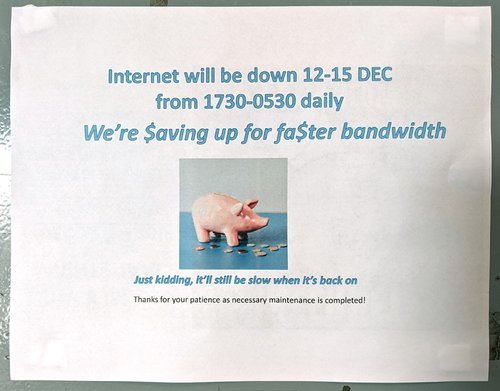
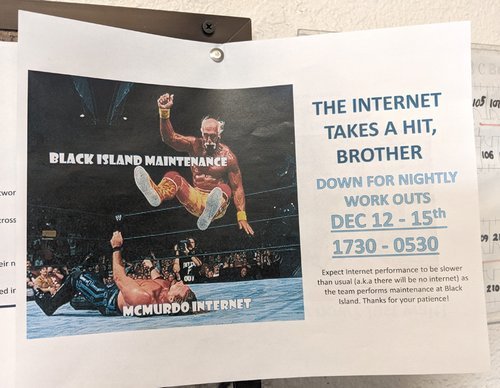
Someday, faster, more accessible internet will come to Antarctica. It's more or less unavoidable, as communications technology improves, and everyone's work – especially the scientists' – depends more and more on having a broadband connection at all times. It will make a lot of things more convenient, and will make the long separation from friends and family much easier. But I'm pretty sure that many more people will mourn the upgrade than celebrate it. One can, theoretically, curtail one's internet use whenever one likes, but even before the pandemic it was almost impossible to live this way with the demands of modern life: I know from personal experience that opting out of Facebook alone can have a real detrimental effect on relationships, even with people one sees in the flesh fairly regularly, simply because everyone assumes that is how everyone else communicates. Being in a community where no one has access to assumed channels, and is more or less cut off from the rest of the world in a pocket universe of its own, levels the playing field and brings a certain unity. The planned (and, unarguably, necessary) updating of the physical infrastructure of McMurdo will wipe out a lot of the improvised, make-do-and-mend character of the place; how much would free and easy access to the online world change it in a less tangible way?
I'm sure the genuine Antarctic old-timers would shake their heads at the phone and email connections we have now, and say that no, this has already ruined Antarctica. It's not Antarctica unless your only link to the outside world is a dodgy radio. It's not Antarctica unless you only get mail once a year when the relief ship arrives. Doubtless the shiny new McMurdo will be seen as 'the good old days' by someone, someday, too. Change may happen slower there than elsewhere, but just like the rust on the tins at Cape Evans, it comes eventually, regardless.
For my own part, I'm glad I got to see 'old' McMurdo, such as it was, all plywood and cheap '90s prefab. The update will be much more efficient, and tidy, but yet another generation removed from the raw experience of the old explorers. My generation is probably the last to remember clearly what life was like before ubiquitous broadband; to some extent, Antarctica is a sort of time capsule of that world, just as the huts are a time capsule of Edwardian frontier life. I hope they'll find a way to hang on to the positive aspects of that.
Now, if you'll excuse me, I'm off to waste an hour mindlessly refreshing Twitter ...
If you'd like to learn more about the Black Island facility, there's a lot of good information (and some photos!) here: https://www.southpolestation.com/trivia/90s/blackisland.html
And this Antarctic Sunarticle goes into greater depth on the 2010 upgrade: https://antarcticsun.usap.gov/features/2114/
270 notes
·
View notes
Text



"Today I learnt" that there is only one permanent settlement on Antarctica called Villa Las Estrellas, which is not a research outpost, just a bunch of people (80 in the winter, 150 in the summer) living far away from everybody else.
The first person born in Antarctica there in 1984.
As of 2018 all residents, including children, are required to have their appendixes removed before coming to Villa Las Estrellas as a safety precaution, as healthcare services are limited.
#Villa Las Estrellas#antarctica#Chilean#chile#south pole#arctic#today i learned#today in the bunker#today in history#research center#Ernest Shackleton#ross ice shelf#global warming#falkland islands#mcmurdo station#scott base#ice shelf#ice sheet#Robert Falcon Scott
23 notes
·
View notes
Text
I recently returned from a patrol to antarctica. For fun I rewatched avatar—but maybe that’s because there’s almost no shows that feature Antarctica (besides The Thing.) and then I realized Zuko spends all his first season in a ship and man, that’s something I can relate to. It’s about to get real nautical up in here with Zuko and the Wani.
Anyway here’s a picture of Mt Erebus, the southernmost volcano in the world. It erupts gold daily and has a lava lake. Picture taken from Observation Hill in McMurdo. Castle rock is in the mid distance

8 notes
·
View notes
Text

McMurdo Station, Antarctica, 2007.
77 notes
·
View notes
Text





The Coffee House (McMurdo Station, Antarctica)
#i genuinely love that there’s an active lgbtq community in antarctica#antarctica#mcmurdo station#the coffee house
10 notes
·
View notes
Text
This is beautiful
I hope they get their cat. I love the Antarctic scientists so much. Give them a cat!!!
5 notes
·
View notes
Text

McMurdo Station, Antarctica field guide...
7 notes
·
View notes
Text

April 25 is World Penguin Day, a celebration of one of the most charming and unique animal species in the world.
This day aims to teach people more about penguins, their habitats, and their importance in the ecosystem.
It also raises awareness about the ways in which we can help protect penguins and their environment as, alarmingly, out of the 17 existing species of penguins, 11 have been classified as endangered.
History of World Penguin Day
World Penguin Day coincides with the day when Adelie penguins begin their yearly migration to the north.
One day, researchers at the McMurdo Station on Ross Island noticed that Adelie penguins always went off on their annual northern migration on April 25.
They thought it would be fun to have a holiday to mark this day, which could also have an educational purpose, raising awareness about the dangers that penguins face.
World Penguin Day also gives scientists, researchers, and marine biologists a platform to educate people about these issues and tell them about ways in which they can help.
Here is a list of the 5 most adorable penguin species:


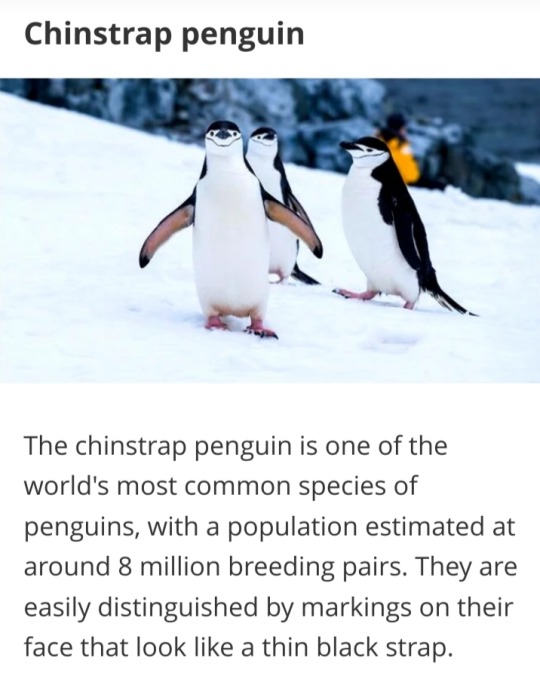
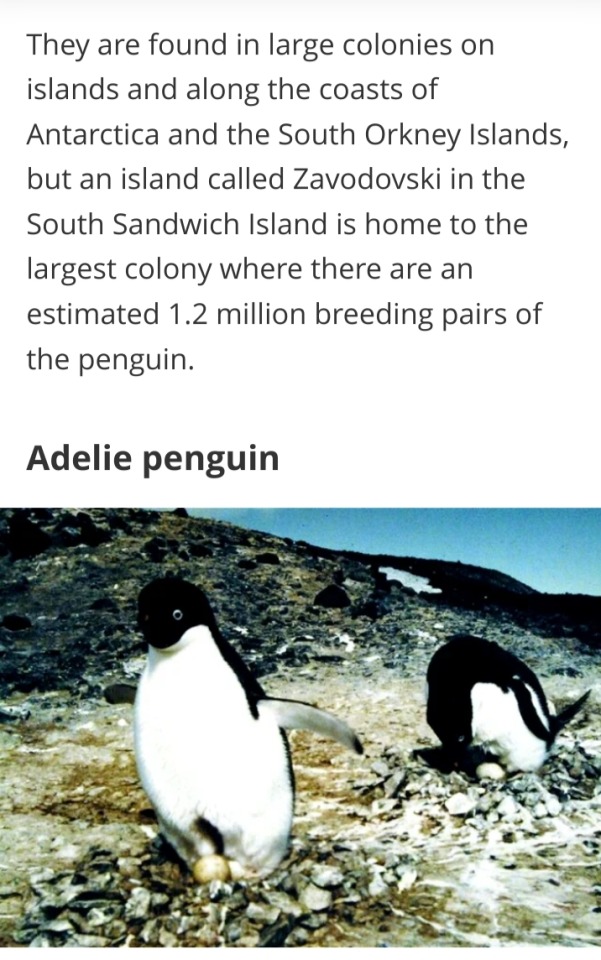


🖤🐧🖤
#World Penguin Day#World Penguin Day 2024#penguins#penguin species#McMurdo Station#Ross Island#northern migration#fairy penguin#blue penguin#emperor penguin#chinstrap penguin#adelie penguin#gentoo penguin
4 notes
·
View notes
Text


Erebus ice tongue ice cave, details.
Ross Island, Antarctica, November 2024.
#antarctica#antartide#scott base#mcmurdo station#mcmurdo sound#ross sea#southern ocean#antarctic exploration#glacier#ice cave#cave#mt Erebus#erebus#ross island#ross dependency#ice crystals#crevasse#penguins#ice tongue#erebus ice tongue#new zealand#antarctica new zealand#original photographers#aesthetic#south pole#speleology#stalactites#polar exploration#polar explorers#ice shelf
10 notes
·
View notes
Text
Oh! I do like to be beside the seaside! I do like to be beside the sea!

1 note
·
View note
Text
Wednesday's temperature check (procès-verbaux of 5-1)
Rabbit! Rabbit! Rabbit!
About a decade ago, astrophysicists determined atmospheric data for the gas giants, Jupiter and Saturn, indicated that carbon is abundant in its dazzling crystal form. Lightning storms turn methane into soot (carbon) which as it falls hardens into chunks of graphite and then diamond. These diamond "hail stones" eventually melt into a liquid sea in the planets' hot cores. The biggest diamonds would likely be about a centimeter in diameter – so, as Beyoncé says, “Cause if you liked it then you should have put a ring on it!” Sure, Saturn already has rings, but now we know has diamonds too. These gas giants get all the cool stuff! Saturn has the rings and Jupiter has that 500-year-old red spot. But what about discoveries further out in the solar system? Well, back in the dark ages (about 15 BI – before Internet) in 1977, the antagonist of Star Trek: The Motion Picture -- Voyager 2 – discovered that Neptune and Uranus also have diamond rain. Can you think of anything more awesome than diamond rain in Uranus? Of course not, don’t we all wish diamonds could shoot out of Uranus? That would certainly justify better reading material in the bathroom. Anyway, a bit closer to Earth, NASA observation has discovered that an active volcano on Antarctica is spewing gold. Mount Erebus, one of Antarctica’s 138 active volcanos, reportedly emits pockets of gas containing crystallized gold each day. These plumes are valued at $6,000 daily and it’s only about thirty miles from my second-favorite station, McMurdo Station (top station is Hits One on Sirius). That sounds like a scheme worthy of Tony Soprano. I’d say Jeff Bezos, but he makes way way more than that just sitting on the toilet. However, the gold is real and there’s a bunch. So, move over African Gold Coast, you’ll have to compete with the gold-covered-continent of Antarctica, now.
Stay safe!
Tom

When you look up Mount Erebus and McMurdo Station, they share the same dot when viewed at this scale. The $6,000 worth of daily gold is not visible as this is an artist’s approximation.
#temperature check#star trek#mount erebus#uran#neptune#saturn#jupiter#gas giants#antarctica#mcmurdo station
0 notes
Text
Antarctic Food
Below you will find my account of eating at McMurdo, but PBS did a whole special on it which has more privileged access and, like, moving pictures and stuff. I highly recommend watching that if you're at all interested in the food question.
As other pleasures in life are restricted or eliminated, food gains significance beyond mere nutrition. When removed from the comforts and diversions of civilisation for months or years at a time, polar explorers had to pay particular attention to the culinary side of their enterprise. Scott learned this the hard way on the Discovery, when their cook was so bad he was sent home after the first year and others took over his job in shifts. Shackleton, on his second visit to Antarctica, brought all sorts of tinned delicacies, and left a lot of them behind in his hut at Cape Royds, which the Terra Nova men would raid on day trips from Cape Evans. Scott was much more careful with his choice of cook on his second expedition, and in his journal he continually praises Clissold's cooking – though Atkinson, writing for a publication he knew no one would read, says that Archer (the ship's cook, who filled in after Clissold was invalided home) was a far superior chef, and made the miserable second winter that much more bearable.
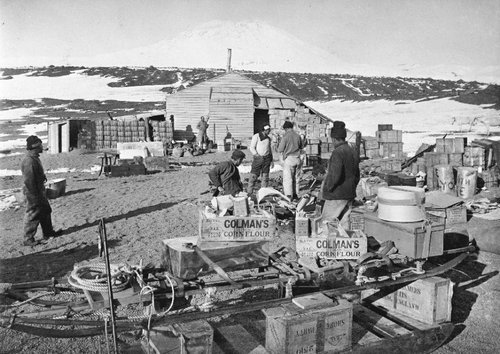
The expeditions of the early 20th Century brought down crates and crates of imperishables – tinned vegetables, powdered milk and eggs, and dry goods like flour, sugar, and tea. These were necessary, of course, but were ultimately supplemental to the core of their diet, which was the produce of Antarctica itself. In fact, in a letter laying out contingency plans if the Terra Nova Expedition were stranded in Antarctica, Scott says not to worry for their safety because the continent provides enough food to keep a party happily fed; they would only be wanting the comforts of a civilised menu. Mostly what the continent provided was seals, whose meat (especially livers) contained enough Vitamin C to stave off scurvy, but penguins and their eggs also regularly passed through the kitchen, and the contents of the marine biologist's net – once properly enumerated and dissected, of course – would often end up in the frying pan. The Notothenia fish was commonly eaten at breakfast, appreciated for its 'sweet' and 'nutty' flavour. Notothenia’s claim to fame is the sugar in its blood that acts as an antifreeze, so this is hardly a surprise.
Thanks to the Antarctic Treaty forbidding the killing of animals for consumption, modern Antarctic larders are not stocked with local wildlife, and as far as I know, no one down there now has tasted the sweetness of Notothenia. They do, however, have the advantage of modern transport and food storage, not to mention a century's worth of advances in the study of nutrition, so the diet of the present-day Antarctican is fresher, healthier, and much more diverse.
McMurdo Station's annual food supply arrives in one lump delivery, every January, on a big cargo ship from California. From the harbour where the Discovery berthed, it goes into climate-controlled storage, either to the dry goods store or to the freezer, which is a whole building off the cafeteria in the main station hub. A freezer, in Antarctica? Why, yes, because food safety regulations require frozen food to be kept at a constant temperature, and the only way to ensure that is to build an enormous manmade freezer in the land of ice and snow. In the summer, temperatures at McMurdo will wander around freezing, so this is entirely practical, but for much of the year, it's actually warmer inside the freezer than outside.
The modern Antarctic commissariat is not entirely divorced from its Edwardian predecessor, though – frozen vegetables taste fresher than tinned, and are more nutritious and palatable, but they are not fresh; powdered milk and powdered eggs are still the status quo. During the summer, perishable groceries – called 'freshies' – come down on the flights from New Zealand, if there is room after the passengers and equipment are loaded. After a month of flight cancellations, fresh apples and oranges are greeted with as much delight as they were on the arrival of relief ships in the Heroic Age, and the appearance of a salad bar in the Galley prompts general rejoicing.
The US Antarctic Program has its roots in the Navy, and McMurdo is still provisioned by one of the big firms that supplies the US military. Having had experience with industrial-scale American catering in California, I had moderate expectations of the quality of food at McMurdo, but it was surprisingly good. One might argue that the excitement of being there and the daily energy expenditure would be a good sauce for anything, and this may be true, but against this I would argue that dry air impedes one's ability to taste – that fact it was so flavourful at all is significant. People kept apologising for the food in the Galley and I kept telling them, earnestly, that it was better than the food in the Disney commissary. They didn't believe me, but I firmly attest this; I ate at Disney on my return journey and have confirmed it by direct comparison. I know they were working with roughly the same quality of ingredients, but the chefs at McMurdo reliably made things delightful to eat, which is more than I can say for the other place. Why this should be is anyone's guess ... Working as a Galley Rat is one of the few ways enthusiasts can get down to the Ice, so it's full of keen, intelligent, and curious cooks, and maybe that rubs off on the food. There are people who come back to tackle the unique challenges of Antarctic cuisine year after year, so maybe they're more experienced and invested in the job. My personal theory is that because they have to eat the food, too, of course they're invested in making it tasty – I suspect the folks behind the counter in LA have much better meals waiting for them when they get home.
Mealtimes follow a strict schedule:
5:30-7:30 Breakfast (many a time I missed the cutoff, woe)
11:00-13:00 Lunch
17:00 to 19:30 Dinner. There was always a portion of the cafeteria serving breakfast food at this time; this was reserved for the night shift workers, who got a reprise of the day shift's dinner for their lunch. If you really liked whatever was served for dinner, nothing could stop you coming around again for another go at midnight.
The one exception to this was Sunday, when a brunch would be served from 10 to 12. The service in the chapel started at 10 as well, and was very weak competition. Brunch was always excellent, and being the single day off, was often where one would meet up with people who were too busy during the week.
If you failed to make a mealtime for any reason, there was always something on offer. A fridge would be stocked with packaged leftovers, sandwiches, and other food-to-go – when I had a day out, I would eat breakfast and then grab my lunch from this fridge. On one occasion, dinner included fried okra (one of my faves, rarely had outside the States) and after stuffing myself with it, I nabbed two or three extra portions and cached them in my dorm room mini-fridge to enjoy later.
In a challenging environment, with a lot of people doing energy-intensive jobs, calories are important. There was only one rule regulating portions: Take what you want, but eat what you take. With a finite amount of food on hand, and delivery only once a year, food waste is anathema – if you need it, then eat it, but do not throw any away.
The menu seemed to originate with whatever presented itself in the enormous freezer, though perhaps in November and December it was dictated more by what remained in it, prior to the new shipment. We didn't suffer for want of variety, though: if anything, we benefited from a surfeit of prawns, including great bowls of them at Sunday brunch. I found myself wondering if the US military had a contract for most of the catch from the Gulf, and how much of their famously inflated budget went into that; I suspect, in reality, the kitchen just hit a seam of prawn in the recesses of the freezer and had to use it up. As a devotee of all shapes of sea bug, I was in seventh heaven, and did my level best to help McMurdo clear the surplus.
Once new food was defrosted and cooked up, it would cascade through various dishes down the week, as leftovers were repurposed to minimise waste. Usually this was successful, but sometimes they had to try a little harder ...
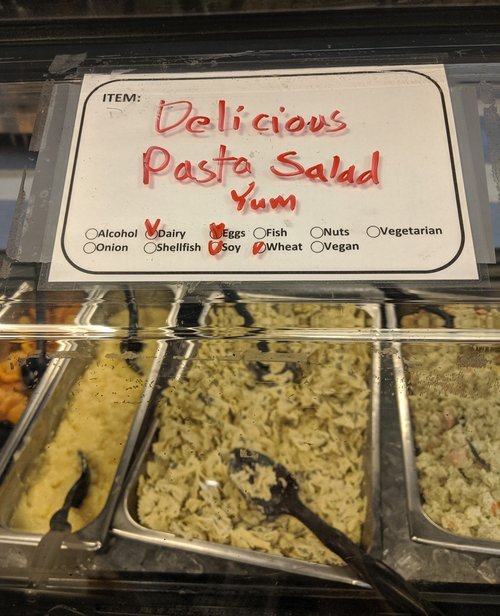
A variety of cuisines were offered, some of which were more successful than others. They seemed to reflect the makeup of the US military, for whom the rations would have been designed. The best dishes were the meat-and-potatoes variety (my minder said that if she were on Death Row, she'd ask for McMurdo Pot Roast for her last meal), Italian, Southern (see above re: okra), and what I assume was Tex Mex – the only misstep on the last count was an almost inedibly hot 'taco soup' which may have been more of a delivery vehicle for leftovers than an intentional dish. The only disappointments were anything attempting to be Asian, and the fish, which, due to the circumstances, was always overcooked. Provision was always made for vegetarians and even vegans, but I can't say I noticed many people adhering strictly to those diets. I suppose if the animals are already dead and in the freezer, there's little difference whether you eat them or not.
There was also, always, pizza. It was left in one of those tiered heated racks like you get at a buck-a-slice takeaway pizzeria, but this was no buck-a-slice pizza, this was McMurdo pizza, and McMurdo pizza is AMAZING. My brother-in-law's cousin went to super legit pizza school in Naples, and gets queues down the street wherever he opens a pizzeria. He makes the best pizza I have ever had anywhere; McMurdo’s wasn't quite as good as his, but it was pretty darn close. It's a testament to how good the rest of the food was that I didn't just have pizza for every meal. The pizza kitchen runs 24 hours a day, and takes orders for pickup from all across the base. If you're flying out to a field camp, it's good manners to take their pizza order and deliver it to them hot and fresh. For all the advances in food technology since the Heroic Age, surely the greatest has to be the McMurdo Pizza.
We were reminded constantly how important hydration was, and the Galley offered a range of liquids at all hours. To my surprise, what looked like a soda fountain offered not pop but fruit juice – grapefruit, orange, cranberry, and apple, though one or more often ran out before the end of breakfast. There were enormous urns of extremely weak coffee – a provision, I supposed, for its diuretic effects – though with 10-hour workdays and very early starts, a little more oomph would have gone a long way. Experienced hands, and those of discerning tastes, brought their own coffee or sourced it somehow from the stores. The kitchenette in the Crary library was full of people's personal coffee-making supplies as they sought a more effective brew.
I had been warned that if I liked tea, I should bring my own; this was a sound warning, as the black tea on offer looked and smelled as though it had been on a shelf for about a decade. What I had not been warned about was that the only 'milk' on hand for one's coffee or tea was, in most places, 'coffee whitener', a ubiquitous Americanism which I'd completely forgotten about (or supressed?) since moving away. For those who've not had the privilege of its acquaintance, this is a blend of margarine, sugar, synthetic vanilla, and titanium dioxide, rendered into a powder by some unknown chemical process and packaged up to pass for milk. (I think it might be illegal in Europe. I've certainly not seen it around.) The Galley had the base's only dispenser of actual mammalian lactation – reconstituted from powdered, of course. If I were to go again, I would bring a small bottle to fill there with 'real' milk, which I could take away for tea purposes elsewhere. There were boxes of UHT milk available for purchase in the shop, and had I been staying longer I might have invested in some, but for just a splash per cuppa, it hardly seemed worthwhile.
The undisputed star of the Galley was the soft serve ice cream dispenser, named Frosty Boy (or Boi), an ancient beast that was such an institution that it was rumoured the USAP had bought another one from a junkyard just for parts. The Thing to Do was, instead of putting milk or coffee whitener in your coffee, to use a dollop of Frosty Boy instead – I'm not sure which end of the dairy/non-dairy spectrum his product was nearest, but it did go well in the coffee, such as it was. More often than not while I was there, Frosty Boy exuded only a watery splutter rather than creamy delight – even when he was working, the product was rather gritty – but I was assured he was just going through a phase, and would be right again soon. I got the impression that if anyone tried replacing the machine with something more reliable, or which produced something more resembling ice cream, there'd be a protest. We shall see if Frosty Boy survives the station revamp, as the NSF seems keen to scrub out any vestiges of character ...
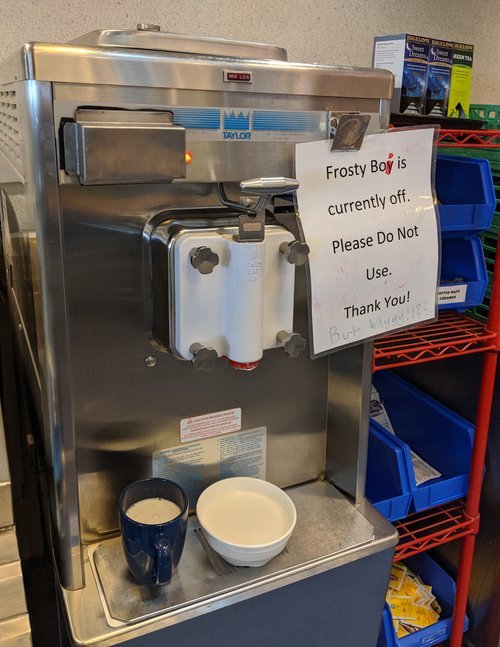
I have brought two things back from the McMurdo Galley, and they're things that go right back to the beginning: powdered milk and powdered egg. Even when I'm near a shop with both in fresh form, it's convenient to have the powdered on hand for recipes. I really only use milk to splash in my tea and coffee, so don't keep a large amount in my fridge, but recipes often call for far more than I have – so instead of making a trip for the extra, I can just mix it up on demand. I've also taken on the Perpetual Yoghurt: McMurdo makes its own yoghurt from its vast reserves of powdered milk, using a bit of the last batch to inoculate the next, and it turns out this is perfectly doable at home, too. Eggs eaten as eggs are better fresh, of course, but when providing structure in a recipe, no one's going to notice if they've been reconstituted, and then I can save my 'real' eggs for when they'll be appreciated. It's a good system, and economical, too. Alas, the pizza isn't as easy to replicate at home ...
For more information on McMurdo food – The Antarctic Sun newsletter put out this podcast: https://antarcticsun.usap.gov/features/4329/ I didn't mention how good the desserts were; I was lucky enough to share my time at McMurdo with Rose McAdoo, who was featured in this story on NPR: https://text.npr.org/779463164
163 notes
·
View notes
Text
Wings Around the Globe Rally
Leg 7
(In the morning, the racers head to the runway.)
AANG (V.O.): We are live from Antarctica, and here they come!

AANG: This is it, race fans. The final leg, back to New York.
(Marinette passes her parents, her plane turbocharged.)
TOM: We’ll see you in New York.
MARINETTE: Thanks, guys.
SABINE: Come on, Tom. We have a plane to catch.
(Nearby, Marinette turns a corner.)
PRESS REPORTER 1: Marinette.
PRESS REPORTER 2: She’s back.
(She heads towards Gabriel.)
GABRIEL: You have to be kidding me.
(He moves to Marinette.)
GABRIEL: Bolting on a few new parts doesn’t change who you are. (SNIFFS) I can still smell the bakery on you.
MARINETTE: You know what? I finally get it. You’re afraid of getting beat by a baker girl!
(She gets in his face, making him edge back.)
MARINETTE: Well, check six, because I’m coming.
(Marinette turns away, anger blazing in her eyes. Gabriel turns to Nathalie and Cash.)
GABRIEL: We are going to end this, once and for all.
CASH: Yeah.
NATHALIE: This is going to be fun.
(From behind a wall, Su-Han watches them leave.)
LEG 7: ANTARCTICA > NEW YORK
15,087 km
SOKKA (V.O.): This one’s all about speed and the willingness to give it all. The racer who cuts the ribbon in New York takes home the trophy and the glory.
Starting line: Williams Field at McMurdo Station in Antarctica
(The final leg starts with each racer taking off one-by-one, a countdown being the starting signal alongside an official dropping the flag. Gabriel takes off, then Nathalie and Cash follow.)
SUKI (V.O.): And we’re off! The first flyers take to the air!

Starting positions:
Gabriel Agreste
Nathalie Sancoeur
Cash
Alya Césaire
Nino Lahiffe
Chloé Bourgeois
Sabrina Raincomprix
Alix Kubdel
Mylène Haprèle
Rose Lavillant
Juleka Couffaine
Ivan Bruel
Kim Chiến Lê-Ature
Max Kanté
Nathaniel Kurtzberg
Kagami Tsurugi
Marc Anciel
Ondine
Marinette Dupain-Cheng
(One-by-one, the racers take off.)

ZUKO (V.O.): The rest of the field is now off and running. And though Dupain-Cheng did not complete the previous leg, race officials ruled her radio had been tampered with, so she’ll be allowed to compete, but with a severe time penalty.
(Marinette sits on the runway ready to go. She just has to wait for the countdown, which is longer than the others’ timers.)

CROWD: …seven, six, five, four, three, two, one, zero!
(The crowd cheers as Marinette sets off over the snowy landscape at max torque.)


AANG (V.O.): I’ve never seen someone come back from this far behind. It’s gonna take both horsepower and willpower to even have a chance.
(The others fly high through the clouds as Marinette travels below just above the ocean.)

(She starts to overtake the other racers one-by-one, starting with Ondine and Marc.)

(Overtaking Mylène and Alix, Rose glances down and sees Marinette race ahead, leaving the ocean surface rippling in her wake.)
ROSE: Way to go, Marinette!

(Marinette continues in her relentless climb up the leaderboard by moving ahead of Nino and Alya.)
ALYA: Whoo! Go, girl!

(She reaches fourth place, just behind Gabriel, Nathalie, and Cash as they approach the Grand Canyon.)
SOKKA (V.O.): Wow. Halfway through the leg, and Marinette Dupain-Cheng has finally caught up to the leaders. What a comeback.
TOPH (V.O.): But is it enough to win?
KATARA (V.O.): Well, considering she started in dead last, and had a time penalty, I think she’s got this in the bag.
Plane repair
Leg 7 - Grand Canyon battle
Back to index
#wings around the globe#miracuclass#tom dupain#sabine cheng#kagami tsurugi#marc anciel#ondine#gabriel agreste#nathalie sancoeur#cash#team avatar#mcmurdo station#antarctica
0 notes